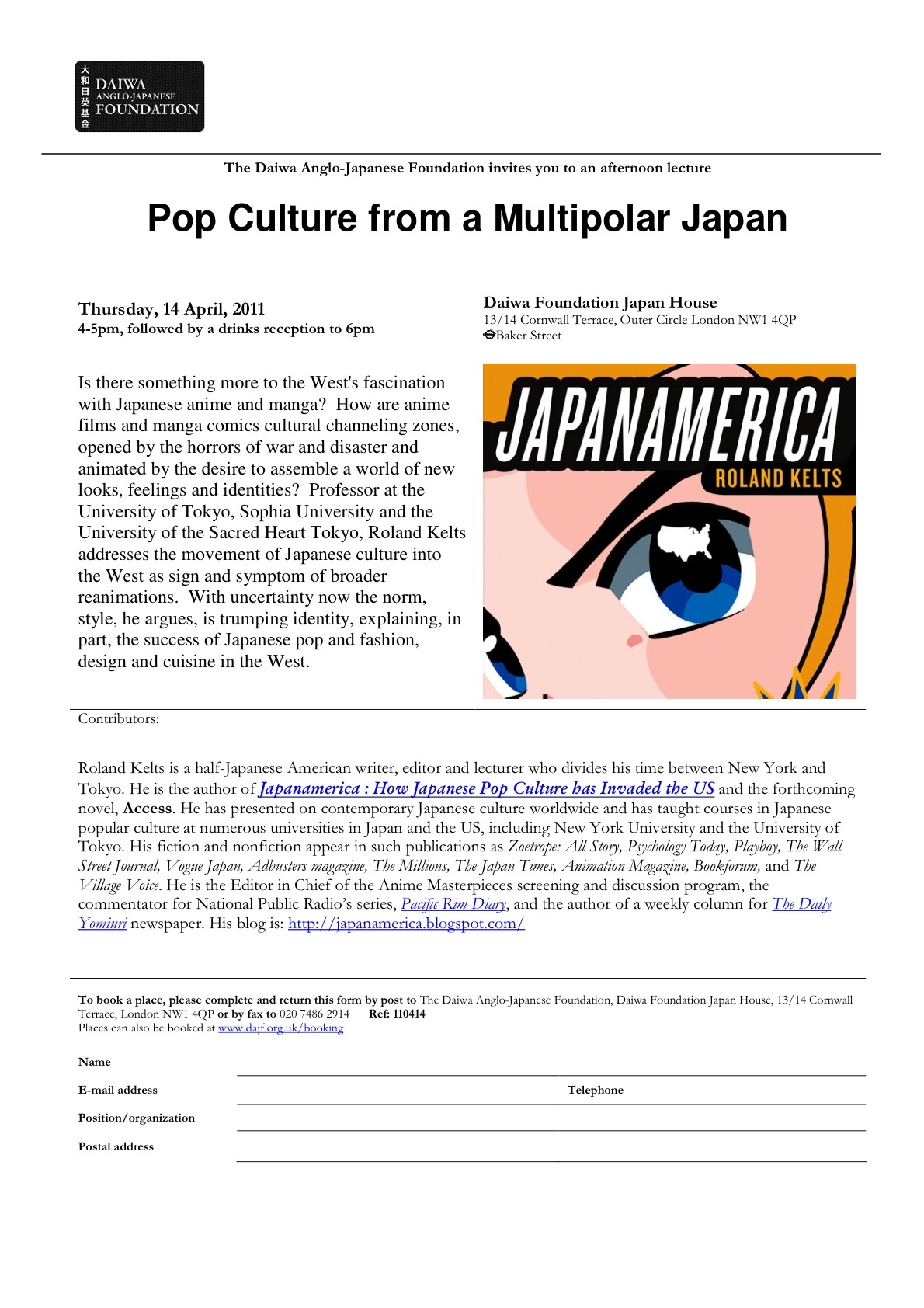Event: JET alum author Roland Kelts to speak in London April 14
*******
Attention JETAA UK! Join Roland Kelts (Osaka-shi, 1998-99), author of Japanamerica, at The Daiwa Anglo-Japanese Foundation in London on Thursday, April 14 for a talk on “Pop culture from a Multipolar Japan.” Talk is 4-5 pm followed by drinks reception to 6pm.
Note: If you plan on attending, please register for the event at http://www.dajf.org.uk/events/booking-form
Japan Center for International Exchange (JCIE/USA) Update: 03.30-03.31.11
The Japan Center for International Exchange (JCIE/USA) has been an excellent source of updates via the earthquake section of its website as well as its Facebook page. The kind of info you’re likely not getting from CNN or network news. Notably, JET alum James Gannon (Ehime-ken, 1992-94) is the Director of JCIE/USA’s New York office. Here’s the latest update:
March 30 – 31 Fund Update: http://www.jcie.org/earthquakeupdate.html
- Increasing signs of mental health issues from stress to ‘survivors guilt’.
- Also, Peace Winds through its partner organization – Mercy Corps – reports on the attention and care being provided to children.
JETs quoted in article on English teaching in Japanese elementary schools
New AJET Chair Matthew Cook (Osaka) as well as Beppu City JET May Schlotzhauer are both quoted in a nice Epoch Times article titled “Japanese Elementary Teachers Take On Teaching English.” (Yes, Epoch Times is the paper connected with Falun Gong, but they have a mix of regular reporting together with propaganda.)
While the article includes some cynical, provocative quotes, it’s also nice to see that the JETs quoted are the voice of experience, perspective and reason in thinking about and commenting on the new requirement to have English in 5th and 6th grades in Japan. This makes sense as JETs are actually working in the schools with teachers and students and positioned to be informed commentators.
Also interesting, toward the end of the article is a description of a proactive attempt by Cook to help prepare the elementary school teachers in his district for the coming requirement. A good example of a role that JETs can (and likely already do) play in school districts around Japan.
“Hoping to help prepare elementary teachers to teach English, Cook lobbied the board of education to host a training seminar, but was turned down. Later the board agreed to allow his school to offer a voluntary seminar to teachers from three local elementary schools. The seminar will be offered once, lasting no more than two hours.”
Here’s the link to the full article:
US-Japan relations take a positive step–Is it good for JET?
Thanks to James Gannon (Ehime-ken, 1992-94) (Executive Director of the Japan Center for International Exchange (JCIE/USA), author of the July 3 “JET on the Chopping Block” post and one of the newest members of the JETAANY Board of Directors) for sharing this Kyodo News Service article. Jim also attended the event in the context of his work for JCIE/USA.
Key U.S., Japan bigwigs huddle to restore ties strained by DPJ
Meeting of minds: Lawmakers, intellectuals and business leaders from Japan and the United States gather at a Tokyo hotel Tuesday to discuss ways to boost bilateral ties.
http://search.japantimes.co.jp/cgi-bin/nn20110223a7.html
No big news to report from the gathering, which included Senator Jim Webb (D-Va). But perhaps this is a step that could lay the groundwork for a stronger US-Japan relationship in the future, which in turn could have a positive impact on the future of JET and JETAA.
Stay tuned.
Japanese primary school teachers unhappy with new English teaching role?
Thanks to JET alum Conrad Chafee for sharing this article from the Daily Yomiuri (2/16/11):
“60% of Schoolteachers Irked by English Classes”
“More than 60 percent of primary school teachers feel teaching English is a burden, according to a survey that also suggests many educators are ill-prepared for the April start of English as a compulsory subject for fifth- and sixth-graders. Benesse Corp., a correspondence education and publishing company, surveyed head teachers in charge of school administration and fifth- and sixth-grade homeroom teachers from 8,000 public primary schools in July and August. About 4,700 teachers gave valid responses.
According to the survey, 62.1 percent of homeroom teachers, who teach all or most of the subjects at primary schools, said they felt teaching English was a burden. About 72.9 percent said they believe it would be better to have teachers who specialize in teaching English to instruct students.”
See the full article at: http://www.yomiuri.co.jp/dy/national/T110215005684.htm
JETs in the News: Lars Martinson featured in Japan Times article on ex-pat comics
********
JET alum/cartoonist Lars Martinson (Fukuoka-ken 2003-2006), author of the graphic novels Tonoharu: Part Two and Tonoharu: Part 1, is the focus (along with Adam Pasion, author of the Sundogs anthologies) of a thoughtful Japan Times article by Gianni Simone on comics about Japan “that tell it like it is.”
Here’s the link to the article: http://search.japantimes.co.jp/cgi-bin/fl20110205a1.html
And below are a few excerpts about Martinson from the article:
The comic life of expats in Japan
Americans Lars Martinson and Adam Pasion tell it like it is with cutting-edge manga
By GIANNI SIMONE Special to The Japan Times
Tales of expat life in Japan all too often get blown out of proportion and quickly become picaresque adventures that little resemble real life.
**********
Luckily for us, many comic artists who have lived here seem to be more level-headed and have tackled the subject with a more realistic, no-nonsense approach.
**********
As the title suggests, “Tonoharu: Part Two” is not Martinson’s first foray in the field of expat comics: He self-published the first volume of this four-part saga in 2008 thanks to a grant from the prestigious Xeric Foundation.
Martinson, 33, first arrived in Japan in 2003 to work as an assistant language teacher, and spent the next three years working at a junior high school in a small town in Fukuoka Prefecture. His second stint in this country was in 2008 when he studied East Asian calligraphy under the auspices of a two-year research scholarship from the Japanese government.
Travel had played a pivotal role in his life (he had lived in Thailand and Norway as well), so when he came up with the idea of producing a graphic novel, he decided to make foreign travel a central theme.
“I planned from the start to turn my Japanese experience into a comic,” Martinson says, “even though I didn’t want it to be a mere autobiographical story. So I chose a 20-something American like me as the protagonist, but added a fictional group of eccentric expatriates living in the same rural Japanese town.”
At times living in the middle of nowhere was a challenge. Still, Martinson has no regrets about those three years spent in Kyushu.
“I’m actually a city slicker,” confesses Martinson, “and would love to live in a huge city in Japan at some point. Also, I’m sure that expat communities are awesome, but they can also separate you from the native population. When you live out in the country, you don’t have the option to just hang out with other Westerners, and this can force you to get involved in the host culture in ways you probably wouldn’t otherwise.”
Click here to read the full article: http://search.japantimes.co.jp/cgi-bin/fl20110205a1.html
Click here to read more JetWit posts about Lars Martinson:
Click here for Lars Martinson’s official blog/website: http://larsmartinson.com
 In the course of creating the JET alum prefectural groups on LinkedIn and encouraging Japanese local government staff to join as well to foster connections and communications, I’ve become aware of the fact that LinkedIn is not anywhere near as popular in Japan as it is in the English speaking world. As word gets around CLAIR of the project, I’ve noticed several Japanese government workers signing up (which is great) who have 0 connections. That means this is the first time they’re using LinkedIn.
In the course of creating the JET alum prefectural groups on LinkedIn and encouraging Japanese local government staff to join as well to foster connections and communications, I’ve become aware of the fact that LinkedIn is not anywhere near as popular in Japan as it is in the English speaking world. As word gets around CLAIR of the project, I’ve noticed several Japanese government workers signing up (which is great) who have 0 connections. That means this is the first time they’re using LinkedIn.
- Does anyone else out there have perspectives on awareness of LinkedIn in Japan, to what extent it’s used, whether there are alternative networks out there that are more popular?
- Please share any insights or thoughts in the comments section of this post.
Yoroshiku onegaishimasu.
–Steven Horowitz (Aichi-ken, 1992-94)
LinkedIn profile: http://www.linkedin.com/in/stevenwaseda
Georgia tries JET-like approach to English teaching
 A New York Times article today describes the push in Georgia to put an English teacher in every school and make English, rather than Russian, the required second language. However, while the article mentions the Peace Corps, Teach for America and the South Korean English language effort (probably EPIK) as similar programs, it does not mention JET for some reason.
A New York Times article today describes the push in Georgia to put an English teacher in every school and make English, rather than Russian, the required second language. However, while the article mentions the Peace Corps, Teach for America and the South Korean English language effort (probably EPIK) as similar programs, it does not mention JET for some reason.
Here’s the link to the article: http://www.nytimes.com/2011/01/24/world/europe/24georgia.html
Justin’s Japan: Nintendo 3DS Comes to America March 27
By JQ magazine’s Justin Tedaldi (CIR Kobe-shi, 2001-02) for Examiner.com. Visit his NY Japanese Culture page here to subscribe for free alerts on newly published stories.
Nintendo announced at a press event today (Jan. 19) that its newest handheld video game console, the Nintendo 3DS, will be available in North America on March 27 for $249.99, hitting stores less than a month after its Japanese debut.
The 3DS is the latest incarnation of Nintendo’s portable DS series, which have sold more than 135 million units worldwide since 2004, making it second to Sony’s PlayStation 2 in total sales. Nintendo’s hook this time that should push them over the top employs a method called autostereoscopy, which provides gaming on a special screen without the need for 3D glasses.
Other features include special augmented reality games, backward compatibility with other DS titles, a Virtual Console service for users to purchase Game Boy and Game Boy Color favorites, 3D movie support, StreetPass and SpotPass mode for wireless and Internet gaming, and a Mii Maker that creates a Mii avatar based off a photo taken with the 3DS’ built-in camera. Other interactive functions, like a pedometer and a 3D camera on the back of the device, are expected to increase the console’s appeal to non-gamers as well, according to Nintendo of America’s president Reggie Fils-Aime.
Click here for the complete story.
WIT Life #150: Tiger Mask, Toshiba’s Strides and a Moncchichi Milestone
******************************************************
WITLife is a periodic series written by professional Writer/Interpreter/Translator Stacy Smith (Kumamoto-ken CIR, 2000-03). She starts her day by watching Fujisankei’s newscast in Japanese, and here she shares some of the interesting tidbits and trends together with her own observations.
Recent articles from the Wall Street Journal and the New York Times brings bright tidings from Japan in the midst of a new year which has started with PM Kan’s low popularity ratings and a still lagging economy. One WSJ article describes the recent phenomenon of the Tiger Mask movement. On Christmas Day last year, a gift of 10 school bags was left at a child welfare facility with a note signed by “Naoto Date.” This was a reference to a character from a popular 1960s manga and TV anime called Tiger Mask. Naoto Date was a wrestling hero who went by the name Tiger Mask and who had grown up in an orphanage.
This act of generosity made by someone adopting this name has inspired numerous copycat donations, and in total there have been Read More
WIT Life #149: 成人の日
WITLife is a periodic series written by professional Writer/Interpreter/Translator Stacy Smith (Kumamoto-ken CIR, 2000-03). She starts her day by watching Fujisankei’s newscast in Japanese, and here she shares some of the interesting tidbits and trends together with her own observations.

Yesterday Japan celebrated 成人の日 (seijin no hi) or Coming of Age Day, and 1.24 million youngsters took part in this celebration (成人式 or seijinshiki). This was the lowest number of participants ever, and the fourth straight year in which the number of 20-year olds has declined. This morning’s news interviewed the 1500 or so Chiba youths who were lucky enough to have their ceremony at Disneyland. They were asked how they felt about becoming adults, and the majority expressed uncertainty regarding their future and being able to find jobs. This year’s group was born in 1990 when the economic bubble burst, and they have Read More
WIT Life #146: 明けましておめでとうございます!
WITLife is a periodic series written by professional Writer/Interpreter/Translator Stacy Smith (Kumamoto-ken CIR, 2000-03). She starts her day by watching Fujisankei’s newscast in Japanese, and here she shares some of the interesting tidbits and trends together with her own observations.
A big akemashite omedetou gozaimasu to everyone! 今年もよろしくお願いいたします。 I hope everyone had a good end to the year and that you are feeling ready for the Year of the Rabbit that we have now entered. I spent the night of 元旦 (gantan) or New Year’s Day with co-workers from the Japanese restaurant that I used to waitress at, and we enjoyed osechi ryouri in lacquer boxes and bowls of ozouni as we watched 紅白歌合戦 (kouhaku uta gassen) or the Red and White Singing Contest. The white or men’s team won for the 6th consecutive year with a healthy margin of over 50,000 votes.
Aside from the usual vapid J-Pop and classic enka, I was really struck by singer Kana Uemura’s トイレの神様 (toire no kamisama), or The Toilet Goddess. This acoustic ballad is a whopping almost ten minutes long, and it tells the story of Read More
Report: “Reinvigorating US-Japan Policy Dialogue and Study” and implications for JET
 There’s a very JET-relevant report just published by the Japan Center for International Exchange titled “Reinvigorating US-Japan Dialogue and Study.” (Notably, JET alum Jim Gannon (Ehime-ken, 1992-94), Executive Director for the US office of JCIE, was involved in the drafting of the report.)
There’s a very JET-relevant report just published by the Japan Center for International Exchange titled “Reinvigorating US-Japan Dialogue and Study.” (Notably, JET alum Jim Gannon (Ehime-ken, 1992-94), Executive Director for the US office of JCIE, was involved in the drafting of the report.)
Though the report only mentions the JET Program once (on page 33 of the report), it’s clear that the still largely untapped resource that is the JET alumni community of over 50,000 worldwide (25,000+ in the US) has the potential and the ability to play a significant role in US-Japan relations going forward given the decline in energy and resources devoted to US-Japan policy dialogue and study cited in the report.
The gist of the report is that “the institutional base of US-Japan policy dialogue and study has started to erode in recent years.” However, the report also “finds fertile ground to deepen bilateral dialogue and better leverage the extensive human networks that have developed between the two societies.”
The main obstacles to reversing this trend appear to be:
- a shrinking institutional base for US-Japan relations and failure to fully take advantage of available resources (e.g., the JET alum community);
- reduced funds available in Japan to support these activities (due in a large part to a down economy); and
- to some extent, increased interest in and focus on China
As JET alums, the above trends may be beyond our control. But we are a big part of that extensive human network that needs to be leveraged. And regardless of the obstacles, the ball is in our court to be part of the solution. Tough times call for innovative solutions.
Gambarimashou.
WIT Life #141: 今年の漢字
WITLife is a periodic series written by professional Writer/Interpreter/Translator Stacy Smith (Kumamoto-ken CIR, 2000-03). She starts her day by watching Fujisankei’s newscast in Japanese, and here she shares some of the interesting tidbits and trends together with her own observations.
The end of the year is upon is, which means that it is time for 今年の漢字 (kotoshi no kanji) or the kanji of the year. It is selected by popular ballot and is supposed to represent the events of 2009. The announcement was made this weekend at Kyoto’s Kiyomizu Temple, and the winner with 14,537 votes was 暑 (sho) or hot. According to Daily Sun, the reason this character was chosen was due to average temperatures this summer hitting historical highs (and many people getting heat stroke as a result) and for the 33 Chilean miners who survived the mine’s hot conditions.
This year had the most cumulative votes ever with 285,406, and the 2nd and 3rd place picks were Read More
The first instalment of JetWit Fashion Beat is brought to you by Dipika Soni (Ishikawa-ken, 2003-06). Dipika currently works as an in-house translator for PFU (a Fujitsu company) in Kahoku-shi, Ishikawa-ken. She is also the vocalist for the Japanese hardcore punk band DEGRADE.
————————————————————————————————————————-
Looking for unique Japanese omiyage? Need ideas for witty Christmas presents? I have found your solution! Look no further than T-shitsu.com.
After 3 years of meticulous planning, designing and market research by a motley crew of friends living in Kanazawa City, T-shitsu.com finally opened their doors to the gaijin community at large earlier this year. The shirts have been steadily gaining in popularity with both the current JET and JET Alum communities due to their fun designs.
The idea behind T-shitsu is to develop a range of witty designs for foreigners to set them apart from their peers in Japan. From the website:
One of us received a shirt as a present many moons ago which has the words ‘I’m Huge in Japan’ emblazoned on it and we all noticed that whenever that shirt was aired, people would comment on it. Every single time.
We searched the web for more shirts along the same vein and were frustrated to see that the options out there are slim to none. The shirts we did find…well… let’s just say “Baka Gai-jin” isn’t the best phrase to have on your chest as a foreigner in Japan!
 In addition to serving the current gaijin clan, I think these shirts make a great gift for anyone who has experienced life as a foreigner in Japan, and Japanophiles in general around the globe.
In addition to serving the current gaijin clan, I think these shirts make a great gift for anyone who has experienced life as a foreigner in Japan, and Japanophiles in general around the globe.
The word “shitsu” means “quality” in Japanese, and the shirts are certainly of a high standard. All designs are available in a wide range of men’s and women’s sizes, and quick home and overseas delivery is possible.
Do also check out the Facebook page for regular updates, t-shirt competitions and general “gai-jin” related chat from the T-shitsu crew. They are always on the look out for new designs so if you have a good idea for a shirt – don’t hesitate contact them!
Last but not least, if you do purchase a shirt from our friends over at T-shitsu.com, please mention that you heard about them from JetWit. Thanks and happy shopping!
Have a suggestion for a future JetWit Fashion Beat post? E-mail dipika [at] jetwit.com.





